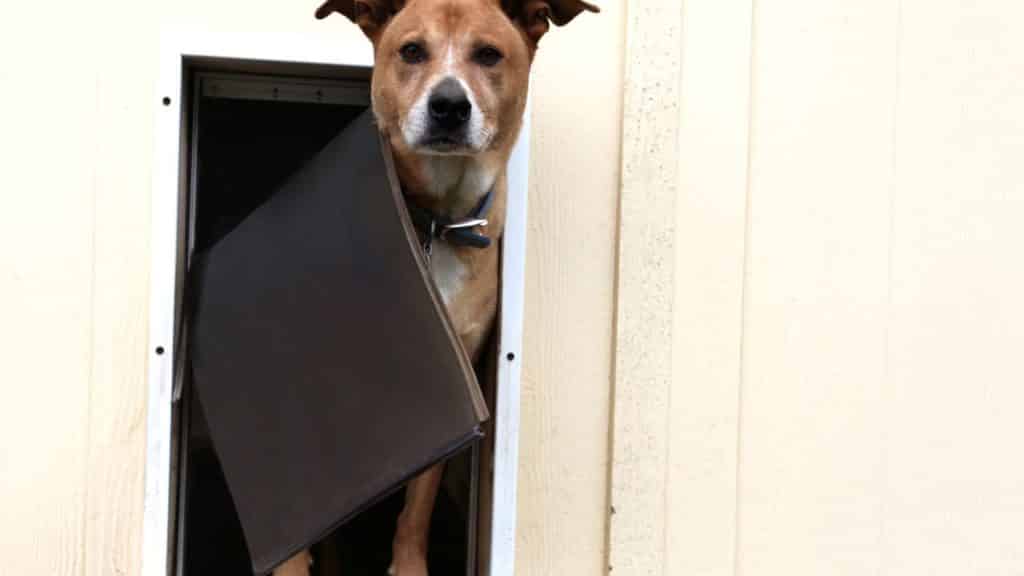
Have you been contemplating installing a dog door in your home? If so, it is important to know the proper time to do so. Installing a dog door during winter can risk your pet’s health and safety as well as increase energy costs. The best time for installation is either early spring or late summer, when temperatures are milder and generally conducive to outdoor activity.
Dog doors installed during winter could lead to an increased chance of frostbite on your pup’s nose or tail if they have any hairless spots from surgery, breed, allergies, etc., which will also result in vet bills that could be avoided with better timing!
When Can a Puppy Use a Dog Door?
A puppy’s age is also a factor that needs to be considered before you install a dog door. Puppies need to learn how to use the doggie door before you put them out on their own.
A time frame of 8-10 weeks should be sufficient for your pup to get the hang of using the dog door. Remember, if you can’t train your dog to use it, it is not the right solution.
Installing a door before 8 weeks could result in injury, so wait until they are old enough.
It may be frustrating training your pup to use the doggie door, but know that the benefits greatly outweigh the efforts by sticking with it!
How Do You Potty Train a Puppy with a Dog Door?
Another factor to keep in mind is how you will potty train your puppy with a dog door. You may need to start this process before or when your pup will be using the pet door for the first time because that’s when they will be most curious about it.
If you do not know where your puppy will eliminate, you will need to closely monitor your little one because they may eliminate in areas you don’t want them to.
Dogs are creatures of habit and repetition, so if they learned where to potty before installing the doggie door, they would likely return to that spot after they get it.
As a result, their potty habits could be disrupted and make training more difficult.
Here are steps to follow
Step 1 – Prepare Your Dog to Go Potty Outside
Take your puppy outside after eating or drinking water. Pay attention to everything around you so you can notice any signs of the pup wanting to go potty.
Step 2 – Make Your Dog Head to the Door
If the pup starts to circle or stops, guide them towards the pet door or door that leads outside. Guide them as you do for kids and make sure they are not afraid of using the pet door.
Step 3 – Let Your Dog Investigate the Door
Give your dog time to become familiar and sniff the door once your dog goes through the doggie door; praise and treat them. If they refuse to go through, wait until they are done with their business and try again.
Please do not put too much pressure on your pet; let them investigate and figure out what they need to do at their own pace and time!
Step 4 – Call Your Puppy to You
Once your pup is used to going potty outside, you can use a keyword or whistle and reward them for coming towards you when they hear it. Then, reinforce the behavior, and after several days start asking them to go through the door before you take them out.
This process may take a few weeks, but it will be worth the effort when your dog is not getting into places it shouldn’t be.
Step 5 – Teach Your Puppy to Go Potty Outside
It is important to potty train your pet at night. You do not want them going through their elimination routines inside while you sleep!
If it’s possible, keep the dog door open throughout the day, so they get used to using it and eventually start using it more often.
Once they know where all the messes should go outside, begin closing the doggie door while you are gone. If your pup is older, you can also consider using a crate.
This will aid in-house training and prevent them from getting into any of your harmful substances or areas where they can get training and help with other behavioral issues because dogs don’t like to mess up where they sleep!
Once your dog starts using the pet door more often without accidents, gradually increase the time you are gone until they can stay at home alone without any accident.
How Long Does it Take a Puppy to Get the Hang of Using a Dog Door?
It can take anywhere from a few days to even a week or two before your puppy gets used to going in and out of the door on his own, as he won’t know why he is going out there in the first place.
Another important factor to consider when training a puppy is to remember that if they never see an animal coming in and going out at a certain time, it could result in a lack of interest in the doggie door itself, which may cause a lack of interest in the doggie door problems with usage.
When your pup sees you going in and out of the door, they will likely follow suit. However, if you only see them scratching at the pet door and barking, they may lose interest in using it because they don’t understand the purpose behind it just yet.
The best thing for your pup is to be exposed to constant activity with the doggie door.
How Long Does it Take Train a Dog to Use a Doggie Door?
Generally speaking, it will take no more than three to five days for your pet to get used to its new doggie door. If you are consistent, that is the only thing that they must do – give them treats when they pass through the dog door and tell them, “Good Dog!”
By encouraging your pet with lots of praise and encouragement, you will be able to train your pet quickly and efficiently.
It is also important that we not give up too early when we begin to train our pets.
Should I Lock the Dog Door When Potty Training My Puppy?
Yes, you should definitely consider locking the doggie door when potty training your puppy.
You can use a piece of furniture or a pet gate to block the entrance. In this way, your dog will not be able to accidentally go through and ruin any hardwood floors or carpets as they learn that going outside is the only thing that is allowed!
Some pet owners will also use a litter box or potty area to house train their pets. If you are using this method, make sure your pet is comfortable using the potty area before you start training them to go outside.
